 (Queen’s) Royal Regiment Tangier,
War of the Spanish Succession, Tongres
(Queen’s) Royal Regiment Tangier,
War of the Spanish Succession, Tongres 
Garrison Duty in the 18th Century
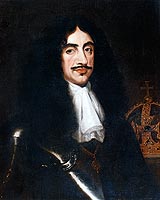 |
|
| King Charles II (Click to enlarge) |
|
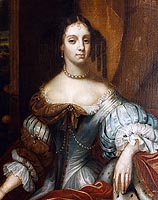 |
|
| Queen Catherine of Braganza (Click to enlarge) |
|
The Queen’s Royal Regiment was originally raised as the Tangiers Regiment to garrison Tangiers, part of the dowry of Princess Catherine of Braganza of Portugal, who was to marry King Charles II of England in 1662. This Regiment became the senior English Infantry Regiment of the Line, taking precedence after the Royal Scots, 1st Foot.
The Tangier Regiment
The Regiment first paraded under its Colonel, the Earl of Peterborough, on Putney Heath on 14th October 1661, and it sailed for Tangier in January 1662. For 22 years the Regiment remained in Tangier guarding the town and the harbour against the continual attacks of the Moors, until in 1684 financial pressures at home led King Charles to abandon the town. On its arrival in England under the command of Colonel Piercy Kirke the Regiment was granted the title the Queen’s Regiment, the Queen being still King Charles’s Queen, Catherine of Braganza. The Battle Honour “Tangier 1662-1680”, the oldest in the Army, and shared with only one other Regiment, now The Royal House Guards Regiment the Blues and Royals, was not awarded until 1909.
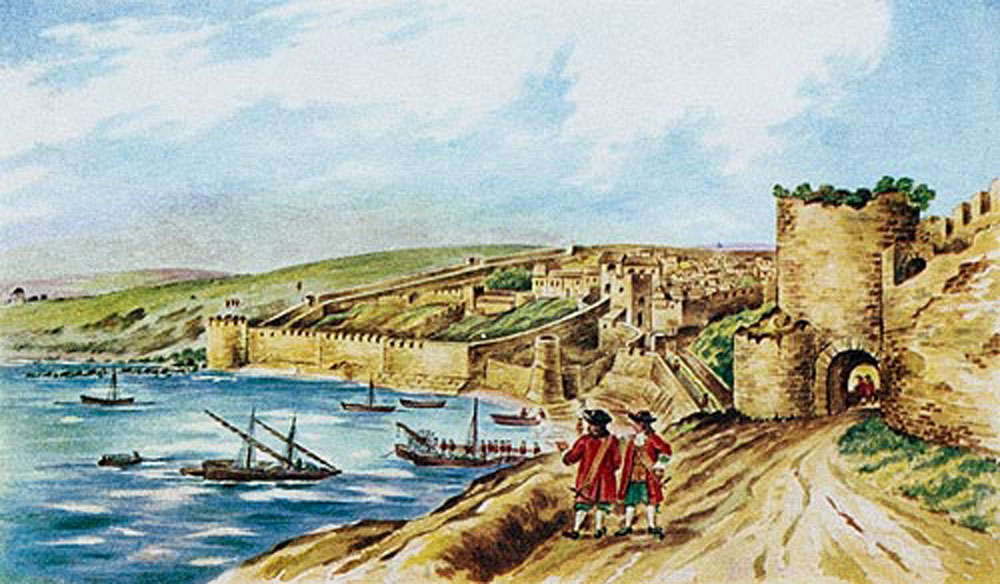
View of Tangier from without the Watergate.

TangierBattle Honour
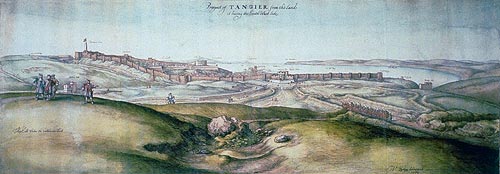
View of Tangier from without the Watergate.
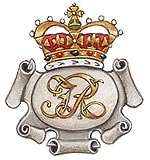
Battles in England and Ireland
In 1685 The Queen’s were part of the Army of King James II which defeated the rebel forces of the Duke of Monmouth at Sedgemoor, near Bridgwater, Somerset. This was the last battle fought on English soil. During this period The Queen’s received the nickname “Kirke’s Lambs”, which some say was popularly awarded for their part in the suppression of the rebels during the Bloody Assizes conducted by Judge Jeffreys. There is probably little truth in this story since the nickname appears to predate 1685, while the Regiment had left the West Country before Judge Jeffreys embarked on his tour of retribution. However, the nickname is of interest on account of its association with the “ancient badge” of the Lamb, which was perpetuated as the Regimental badge, was apparently being worn in 1685. The Paschal Lamb is a dominant motif in Princess Catherine’s former home at Braganza, and it may have been adopted by the Regiment as a Christian emblem during its battles against the Moors in Tangier.
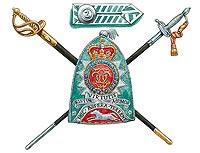 |
|
| Grenadiers Cap (Click to enlarge) |
|
Four years later, in 1689, the Regiment had to fight much harder in Ireland against King James, when he tried to regain his throne from his son-in-law, William III (of Orange), who had replaced him the year before. At the Battle of the Boyne, on 1st July 1690, the historian Lord Macaulay described The Queen’s as beginning their long career of glory, they having already played a significant role in the relief of Londonderry.
The Low Countries and the War of the Spanish Succession
After their service in Ireland, the Regiment was transferred to join William III’s forces defending his Dutch possessions in the Low Countries against Louis XIV and fought with distinction at the Battle of Landen and the Siege of Namur. Although, in 1697, an uneasy peace was established it was not long before what became known as the War of the Spanish Succession started in 1702, and at the beginning of this The Queen’s were part of the Duke of Marlborough’s Army of English and Dutch troops in the Low Countries and Flanders. It was then, in 1703, that the Regiment specially confirmed and established its reputation for tenacity and courage, by its conduct at Tongres.
The Action at Tongres
The main body of the Army under Marlborough was deployed besieging Bonn on the Rhine, while the remainder was scattered in the Low Countries under Marshal Overkirk, the Dutch Commander. The Queen’s together with a Dutch battalion were in a forward position in the town of Tongres, near Liege, when the opposing French Marshals Bouffiers and Villeroi decided to advance rapidly with 40,000 men to destroy the scattered Dutch units. Only Tongres stood in the way, but in spite of being surrounded by overwhelming forces, The Queen’s and the Dutch battalion stood fast for 28 hours, and gave time for Marshal Overkirk to concentrate his forces, and the French had to abandon their plans.
For this action The Queen’s Regiment was given the title “Royal” and the mottoes “PRISTINAE VIRTUTIS MEMOR” (Mindful of their Former Glory) and “VEL EXUVIAE TRIUMPHANT” (Victorious even in Adversity). The men of both Regiments at Tongres became prisoners of war, but not for long as their release was negotiated three months later. On reforming, The Queen’s were sent to join the Army in Spain in 1704, only to be virtually destroyed again at the Battle of Almanza in 1707. Reformed once more they took part in the Expedition to Canada in 1711, but this achieved little and when the War was ended by the Treaty of Utrecht the Regiment was in England where it was to remain until 1730.
Garrison Duty in the 18th Century
After their long spell at home The Queen’s saw little of England during the remainder of the Century. In June 1730 the Regiment embarked for Gibraltar where it was to remain until 1749 - during this time Lieutenant General Piercy Kirke (the Younger) died on 1st January 1741 having been in command of the Regiment for 30 years - a somewhat longer tenure than is customary today! After Gibraltar, The Queen’s were in Ireland for 16 years, receiving new Colours at Waterford in the centenary year of 1761. In 1765 they went to the Isle of Man for 3 years and returned to Gibraltar until 1775, when at last they came home after an absence of nearly 50 years. However Gibraltar called again in 1783, and the Regiment remained there until returning to England in 1792, in time to take part in the wars against Revolutionary and Napoleonic France that, with one interval of 19 months, were to drag on for 22 years. During its last tour in Gibraltar the Regiment was commanded for 6 months by Prince Edward, Duke of Kent, who was the father of Queen Victoria, forming a link with another Queen who, in her time, took a special interest in the Regiment.
Related
